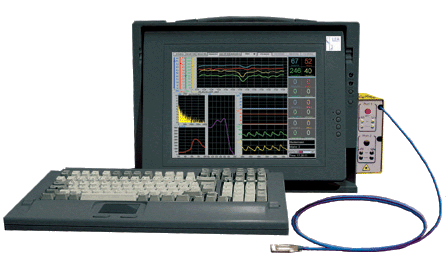O2C (oxygen to see)

O2C (oxygen to see) |

|

The optical sensor is easy to handle and guarantees reproducible examinations of local oxygen supply of tissues in clinics as well as in research. The examinations are without any strain for your patient.
![]() determines by use of a glass fibre probe:
determines by use of a glass fibre probe:
This device makes it possible to supervise the local oxygen supply of organs and tissue.
With this system it is possible to diagnose:
With
![]() it is possible
to measure locally the amount of oxygen which is transported into the region
of interest and to diagnose local oxygen consumption of an organ. O2C's
novelty is monitoring the energetic metabolism of cells by measuring the
oxygen uptake with an optical sensor probe. Pathological O2-supply,
which can lead to angiogenesis or cell-death and subsequently to organ failure,
now can be detected in an early state by use of the new sensor system.
it is possible
to measure locally the amount of oxygen which is transported into the region
of interest and to diagnose local oxygen consumption of an organ. O2C's
novelty is monitoring the energetic metabolism of cells by measuring the
oxygen uptake with an optical sensor probe. Pathological O2-supply,
which can lead to angiogenesis or cell-death and subsequently to organ failure,
now can be detected in an early state by use of the new sensor system.
![]() is a multiple
channel system which makes it possible to determine perfusion quantities
and oxygen values. Channel 1 records the superficial oxygen saturation of
hemoglobin (e.g. of the skin), while channel 2 monitors the oxygen supply
and hemoglobin values of deeper tissue (e.g. skeletal muscle), due to the
extended measurement volume.
is a multiple
channel system which makes it possible to determine perfusion quantities
and oxygen values. Channel 1 records the superficial oxygen saturation of
hemoglobin (e.g. of the skin), while channel 2 monitors the oxygen supply
and hemoglobin values of deeper tissue (e.g. skeletal muscle), due to the
extended measurement volume.
The measurement principle of the device relies on a combination of laser-Doppler-technique and tissue spectrometry. Different application at the skin, internal organs and in the intestinal tract are possible by flexible glass fibre probes .

The main screen is divided into the following parts, providing you with a good overview for all clinical problems:
O2C
is available in 15 variations. The variations differ in number of connected
probes, the different number of channels, measuring depths of a probe and
the parameters which can be recorded per channel.
A measurement channel is usually equipped both with a laser-Doppler measurement
unit and with a tissue-spectrometer-unit with white light source (O2C).
For the different device and technical data refer to the pdf
file.